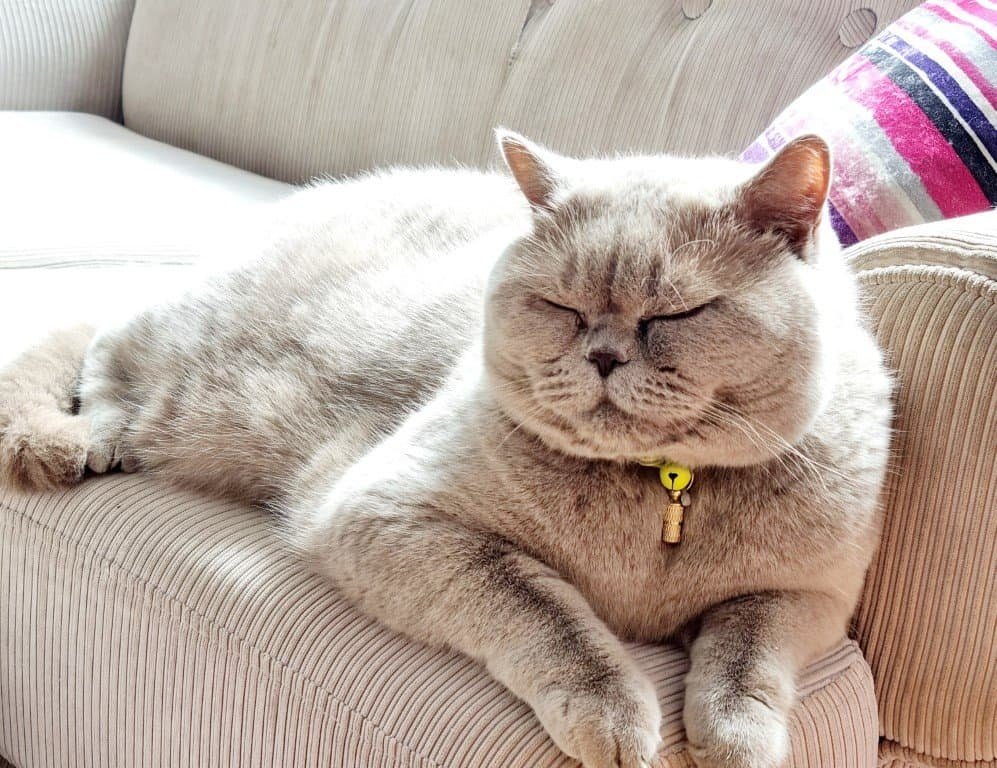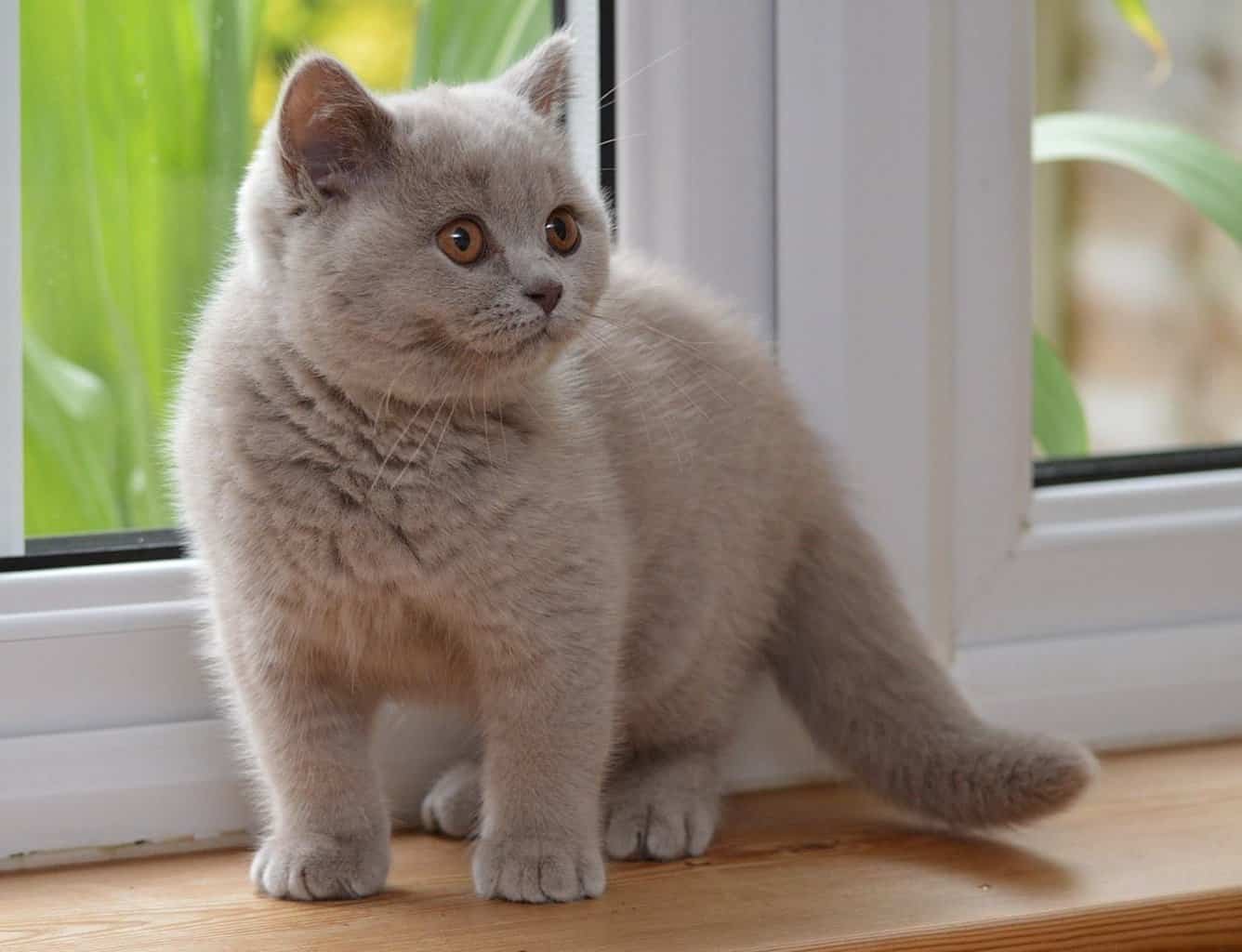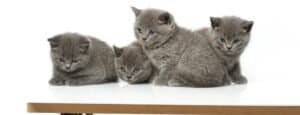How would you like an in depth look at the British Shorthair cat breed profile?
You've always been attracted to British Shorthair cats and just want to make sure the breed is right for you before finding a kitten.
You have a few questions, maybe even a few concerns . . .
More...
So as a GCCF British Shorthair cat judge I am sure I can help.
Let me introduce you to the wonderful British Shorthair cat breed.
A Charming Brit with a Teddy Bear Soul
There’s something delightfully old-fashioned about the British Shorthair. With their plush coats, chunky builds, and stoic demeanours, they look like they belong perched on the windowsill of a country cottage, watching the world go by with a raised eyebrow. They're not the clingy, lap-cat type — they’re dignified, composed, and utterly British.
As a breeder, behaviourist and GCCF judge, I’ve met countless British Shorthairs, and the best of them are a joy to be around. Calm, gentle, and ever so slightly aloof — they have all the charisma of a Victorian headmistress, but with a far softer coat.Origins and History of British Shorthairs
The British Shorthair is one of the oldest recognised cat breeds, believed to descend from cats brought to Britain by the Romans. These cats were likely kept to control rodents, and over time, they developed into the robust, thick-coated cats we know today, thanks to natural selection and the chilly British climate.
The breed’s modern journey began in the 19th century, when cat fanciers began selectively breeding the best examples. Harrison Weir, often called the “father of the cat fancy”, was instrumental in their development. The iconic ‘British Blue’ became especially popular.
However, both World Wars were devastating for the breed, and numbers declined drastically. Breeders crossed British Shorthairs with Persians and other breeds to save them, which introduced some of the plush coat and rounder features we see today.
Today, the British Shorthair is one of the most popular breeds in the UK — and rightly so.
British Shorthair Cat Description
British Shorthairs are a medium to large sized breed of cat, with compact, cobby bodies. They should look powerful and muscular with thick, short necks and a massive, round head. Their ears should be medium in size; set fairly well apart and they should have large, round eyes. They have thick tails that should be rounded at the tip. Their tails should be no longer than 2/3 the length of their body.
A British Shorthair has a dense, short coat that feels firm and plush when you touch it. They have a lot of undercoat, contributing to their teddy bear-like appearance.
They are available in most colours and patterns including tabby and bi-colour, tortie and colour-point. The most popular colour is the British Blue.
Eye colour depends on the coat colour, with many British Shorthair having copper eyes. Other eye colours include green, gold, blue and odd eyed. Colour-points always have blue eyes.



Blue British Shorthair that was featured in the 2025 edition of the CattyLicious BSH Calendar!
Physical Characteristics (Based on GCCF Standard)
British Shorthairs are compact, powerful cats with a balanced, symmetrical appearance. According to the GCCF breed standard, here’s what defines them:
- Head: Large and round with full cheeks (especially in males), a short, broad nose, a firm chin, and rounded whisker pads. The skull should be broad and slightly domed.
- Eyes: Large, round, and expressive. The classic eye colour for blues is deep gold to copper, but this varies with coat colour — self white and colourpoints may have blue eyes; tipped and shaded may show green.
- Ears: Small to medium, rounded at the tips, and set well apart, following the contour of the head.
- Body: Medium to large, with a broad chest, strong legs, and a level back. The overall appearance should be cobby and muscular.
- Tail: Thick at the base, of medium length, and with a rounded tip.
- Coat: Dense, short, and plush — it should feel crisp, not soft or woolly.
Common Colours:
- Solid Colours: Blue (the most iconic), black, white, cream, red, chocolate, lilac
- Patterned Varieties: Tabby, colourpoint, bi-colour, tortie, shaded, and more
There are over 300 recognised colour and pattern combinations in total — so you’re spoiled for choice!
Interesting British Shorthair Facts.
The British Shorthair almost went extinct during World War II due to food shortages.
The Cheshire Cat from Lewis Carrolls’ Alice in Wonderland was inspired by none other than a British Shorthair.
Personality and Behaviour of British Shorthairs
British Shorthairs are calm, confident, and quietly affectionate. They’re not needy, but they do enjoy being near their people — just not on them. If you're expecting a cat that clings to your leg like a toddler, this breed may not be for you.
They are intelligent, but not prone to mischief. You won’t find them swinging from your curtains or launching surprise attacks from under the sofa. A British Shorthair would consider such behaviour utterly beneath them.
Typical Traits:
- Quiet and low-energy
- Independent but friendly
- Tolerant with children and other pets
- Not particularly vocal
- Affectionate without being demanding
A British is more likely to sit beside you than in your lap, and when they do decide to share your sofa, you’ll feel honoured.
Living with a British Shorthair
This breed fits beautifully into a calm, steady household. They’re excellent for working people, as they can happily entertain themselves during the day. They’re not likely to develop separation anxiety, though they do enjoy your company when you're home.
They make wonderful companions for older adults or families with gentle children. British Shorthairs don’t tend to scratch furniture or climb the curtains — their play is more dignified. Think chasing a felt mouse across the floor rather than scaling a cat tree.
Indoor vs Outdoor:
They adapt well to indoor life. If allowed outside, it should be in a secure garden or supervised space — they’re not the most agile or fast-reacting cats, and urban dangers aren’t their forte.
Grooming:
British Shorthairs are very easy to groom and their short, thick coats will only need a brush or a comb once a week to keep them looking good. Be sure to remove all the dead hair during this weekly grooming session.
When the British Shorthair starts to shed you will need to groom them two or three times a week. This usually occurs for a couple of weeks in the spring and the autumn as they grow their new coats.
As with all breeds of cat, grooming should include keeping their claws trimmed and their ears clean and free from dirt. British Shorthair kittens quickly get used to being groomed and having their ears and teeth checked weekly.
Diet:
They’re not fussy, but they do enjoy their food. Portion control is a must, as they can be prone to weight gain.



Lilac British Shorthair that was featured in the 2025 edition of the CattyLicious BSH Calendar!
Health Considerations
British Shorthairs are generally healthy, but like all breeds, they have a few known issues:
- Hypertrophic Cardiomyopathy (HCM): A heart condition that can be inherited. Responsible breeders scan their cats.
- Polycystic Kidney Disease (PKD): Although less common now, it’s still seen in some lines.
- Obesity: They have a tendency to put on weight — keep an eye on portions and encourage gentle play.
Considering the British Shorthair?
If you’re still weighing up whether this breed is right for you, here’s who they’re best suited to:
British Are Ideal For:
- First-time cat owners
- Families with calm children
- Seniors or quieter households
- Working adults or part-time workers
British May Not Be For:
- People who want a cuddly lap cat
- Homes seeking a super active or playful breed
- Those expecting constant interaction or noise
They’re more “quiet companion” than “furry tornado”. If you want calm, character, and charm — you’ll love them.
I once judged a British blue queen who sat in her pen like royalty. As I approached, she didn’t move a muscle — just gave me a regal, slow blink that said, "Yes, you may examine me now." She was flawless. Calm, composed, and perfectly British.
- Ross DavieS, GCCF Cat Judge
British Shorthair Cat Gallery
Below are some British Shorthair cat pictures, please feel free to contact us if you would like to contribute any photos of your own British Shorthair cats and kittens, we would love to include them!














faq
Yes, especially if the children are gentle and respectful. They don’t tolerate rough handling.
No. They like being around you but aren’t needy. They’re independent.
They enjoy short bursts of play but are generally laid-back. So not very active at all, once they are out of 'kitten-hood' they are rather relaxed about everything,.
Life expectancy of a British Shorthair cat is generally excellent with reported lifespan of 12-15 years.
Absolutely. Their quiet nature makes them ideal for indoor life.
No, British Shorthairs are fairly quite.
British cats do love people but prefer to keep their feet firmly on the ground and so prefer not to be picked up.
Find Out More About British Shorthair Cats


Choosing a British Shorthair Breeder in the UK: Red Flags and Green Lights
When it comes to choosing a British Shorthair, the breeder you select plays an important role in ensuring you get a healthy, well-socialised kitten with a solid foundation for life. After all, the health and temperament of your new cat start long before you bring them home.As a breeder and GCCF judge with years of . . .


Do British Shorthairs Get Along with Other Cats?
One of the questions I get asked a lot as a breeder and cat judge is whether British Shorthairs get along well with other cats. As someone who’s lived with British Shorthairs for years, including my own lovely cat, Rosie, I can confidently say that the breed is generally quite tolerant of other cats, but . . .


British Shorthair Independence: Can British Shorthairs Be Left Alone?
If you’re a busy professional or have a lifestyle that requires you to leave your cat alone during the day, you might be wondering if your British Shorthair will be okay while you’re out. After all, British Shorthairs are known for being calm, independent cats—but does that mean they’re happy left to their own devices?As . . .


British Shorthair Neutering: When to Neuter a British Shorthair and Why It Matters
When you bring home a British Shorthair kitten, one of the decisions you’ll face is when to arrange neutering. Whether you’re welcoming a future family pet or planning to show or breed, understanding the right timing and reasons for neutering is essential for your cat’s long-term health and wellbeing.As someone who owns British Shorthairs, including . . .


British Shorthair Vocalisation: Are British Shorthairs Quiet Cats?
One of the first things many British Shorthair owners notice is how quiet their cat is. Compared to the chatty Siamese or the opinionated Bengal, British Shorthairs can seem almost silent. It’s not unusual for a new owner to wonder, “Is something wrong, or are they just… very British?”As someone who lives with Rosie, my . . .


British Shorthair Play: Do British Shorthairs Like Toys?
British Shorthairs are often described as “sedate” or “lazy,” but that’s not really fair. They’re thoughtful players. They don’t go in for endless zoomies or wild, chaotic chases like some breeds do, but they absolutely enjoy a good game, especially if it taps into their natural hunting instincts.The trick is to offer toys that match . . .


The British Shorthair Kitten Checklist: What You’ll Need
Bringing home a British Shorthair kitten is one of life’s greatest pleasures. Those round faces, stocky bodies, and mischievous personalities can melt even the sternest of hearts. But before you welcome your new bundle of fluff, you’ll need to make sure your home is ready.As someone who’s lived with British Shorthairs for years, including my . . .


British Shorthair Weight: How Heavy Should a British Shorthair be?
British Shorthairs are known for their solid build, round faces, and sturdy bodies. They’re not dainty little lap cats, they’re built like little tanks, with broad chests and strong limbs. But with that natural heft comes a challenge: how do you tell the difference between a healthy, solid British Shorthair and one that’s carrying a . . .


British Shorthair vs Ragdoll: Which Cat Suits You Best?
When it comes to choosing a cat breed, two of the most popular—and often compared—options in the UK are the British Shorthair and the Ragdoll. Both breeds are known for their calm nature, affectionate personalities, and good looks. But they also have key differences that might make one better suited to your home and lifestyle . . .


How to Litter Train a British Shorthair Kitten
Litter training is one of the first things you’ll need to tackle with a new British Shorthair kitten, and fortunately, British Shorthairs tend to be fairly easy when it comes to toilet habits. They’re clean, intelligent cats that catch on quickly, but like with anything, setting the right foundation is key.As a cat breeder and . . .


British Shorthair Behaviour Myths: Lazy, Cold, or Just Very British?
If you’ve ever come across a British Shorthair, you might have heard all kinds of things about their behaviour. “Lazy”, “aloof”, and “cold” are just a few of the adjectives that seem to follow this breed around. But are these descriptions really accurate, or is there more to these dignified cats than meets the eye?As . . .


British Shorthair Colours and Patterns: From Blue to Bi-Colour
British Shorthairs are famous for their chunky builds, teddy bear faces, and plush coats… but have you ever wondered just how many colours and patterns they come in?Most people immediately think of the classic “British Blue” when they picture a British Shorthair, and fair enough, that iconic slate-grey coat is beloved worldwide. But there’s a . . .


Common British Shorthair Health Issues and How to Prevent Them
British Shorthairs are often described as one of the more robust cat breeds, and it’s true they’re generally healthy, hardy souls. That said, no breed is entirely free from health risks, and British Shorthairs do have a few issues that owners should be aware of.As someone who lives with Rosie, my black British Shorthair queen . . .


Keeping a British Shorthair inside, can British Shorthairs be happy indoors?
British Shorthairs are famously calm, steady, and a little bit aloof. With their stocky builds and quiet ways, many people assume they are perfectly suited to indoor life… but is that really true? As someone who lives with Rosie, my glorious black British Shorthair, and as a feline behaviourist and judge, I can tell you this: . . .


Are British Shorthairs Good with Kids, Dogs, and Other Cats?
British Shorthairs are often described as calm, dignified, and quietly affectionate—but how do they actually get on with children, dogs, and other cats?As a GCCF judge and feline behaviourist, I’ve seen hundreds of British Shorthairs interact with families and other animals. And as someone who shares his life with Rosie, a black British Shorthair with . . .


British Shorthair Development: Kitten to Adult What Changes as They Grow?
British Shorthair kittens have a special kind of charm. Round-faced, stocky, and full of mischief, they look like they’ve waddled straight out of a cartoon. But these little fluffballs have a lot of growing up to do—and they take their sweet time doing it.As a cat judge and qualified feline behaviourist, I’ve had the pleasure . . .


Grooming a British Shorthair: How Much Brushing Do They Really Need?
British Shorthairs are famous for their plush, teddy bear-like coats, but don’t be fooled by appearances. Although their fur is thick and luxurious, grooming them is surprisingly straightforward—as long as you stay on top of it.As someone who’s bred, judged, and lived with British Shorthairs for decades, I’ve had my fair share of fluff-filled laps . . .


Are British Shorthairs Affectionate?
British Shorthairs are one of the most beloved cat breeds in the UK. With their plush coats, rounded features, and dignified manner, they look like the perfect cuddly companion. But looks can be a bit misleading if you’re expecting a cat that wants to be scooped up like a ragdoll and cradled all day.As someone . . .


Feeding a British Shorthair: Diet Tips for a Breed Prone to Chunkiness
If ever there were a cat breed that could win a medal for looking like a teddy bear in feline form, it’s the British Shorthair. Stocky, plush, and round-faced, they’re built like little tanks, and they eat like them too, given half the chance. I’ve shared my home with these delightful cats for decades, and . . .


British Shorthair Personality: Calm, Aloof, or Just Misunderstood?
The British Shorthair is often portrayed as the quintessential British feline . . . reserved, dignified, and perhaps a tad aloof. But is this portrayal accurate? As a cat breeder, GCCF judge, and feline behaviourist with over 25 years of experience, I’ve had the pleasure of sharing my life with British Shorthairs. Their temperament is . . .
Recommended Resources
GCCF Breed Information
The GCCF British Shorthair page is the go-to source for the official breed standard in the UK. It outlines exactly what judges look for in the show hall, making it essential reading if you're interested in showing or breeding British Shorthairs.
British Shorthair Cat Club
The British Shorthair Cat Club website is a valuable resource for anyone serious about the breed. It offers direct insight from one of the UK’s official breed club, including show updates, breeder contacts, and guidance aligned with the GCCF breed standard.

I love my British blue he is lovely but dose not take kindly to people he does not know.